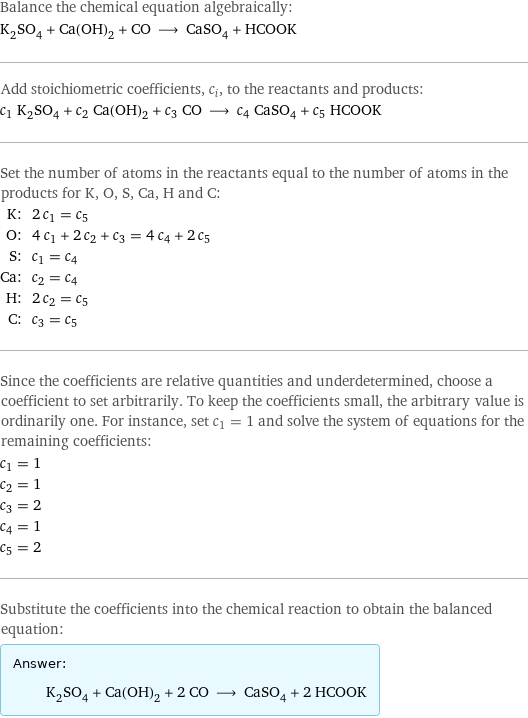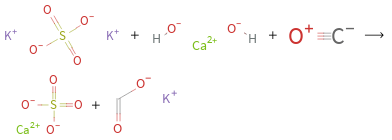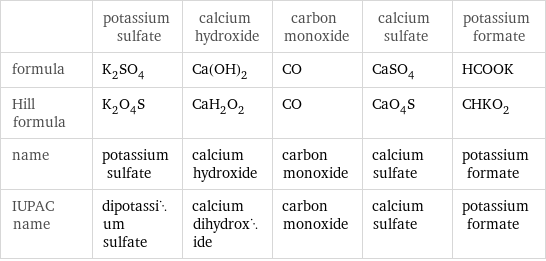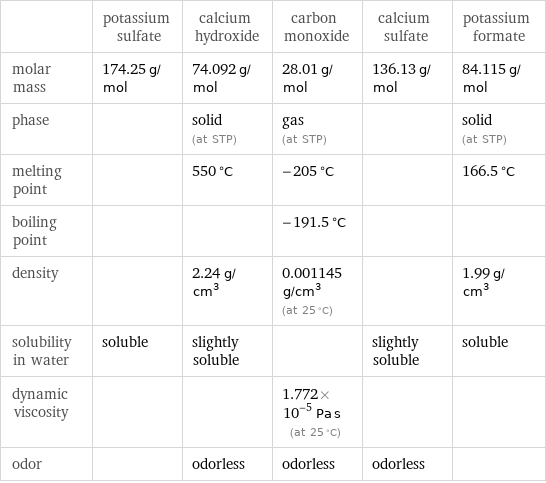Input interpretation

K_2SO_4 potassium sulfate + Ca(OH)_2 calcium hydroxide + CO carbon monoxide ⟶ CaSO_4 calcium sulfate + HCOOK potassium formate
Balanced equation

Balance the chemical equation algebraically: K_2SO_4 + Ca(OH)_2 + CO ⟶ CaSO_4 + HCOOK Add stoichiometric coefficients, c_i, to the reactants and products: c_1 K_2SO_4 + c_2 Ca(OH)_2 + c_3 CO ⟶ c_4 CaSO_4 + c_5 HCOOK Set the number of atoms in the reactants equal to the number of atoms in the products for K, O, S, Ca, H and C: K: | 2 c_1 = c_5 O: | 4 c_1 + 2 c_2 + c_3 = 4 c_4 + 2 c_5 S: | c_1 = c_4 Ca: | c_2 = c_4 H: | 2 c_2 = c_5 C: | c_3 = c_5 Since the coefficients are relative quantities and underdetermined, choose a coefficient to set arbitrarily. To keep the coefficients small, the arbitrary value is ordinarily one. For instance, set c_1 = 1 and solve the system of equations for the remaining coefficients: c_1 = 1 c_2 = 1 c_3 = 2 c_4 = 1 c_5 = 2 Substitute the coefficients into the chemical reaction to obtain the balanced equation: Answer: | | K_2SO_4 + Ca(OH)_2 + 2 CO ⟶ CaSO_4 + 2 HCOOK
Structures

+ + ⟶ +
Names

potassium sulfate + calcium hydroxide + carbon monoxide ⟶ calcium sulfate + potassium formate
Equilibrium constant
![Construct the equilibrium constant, K, expression for: K_2SO_4 + Ca(OH)_2 + CO ⟶ CaSO_4 + HCOOK Plan: • Balance the chemical equation. • Determine the stoichiometric numbers. • Assemble the activity expression for each chemical species. • Use the activity expressions to build the equilibrium constant expression. Write the balanced chemical equation: K_2SO_4 + Ca(OH)_2 + 2 CO ⟶ CaSO_4 + 2 HCOOK Assign stoichiometric numbers, ν_i, using the stoichiometric coefficients, c_i, from the balanced chemical equation in the following manner: ν_i = -c_i for reactants and ν_i = c_i for products: chemical species | c_i | ν_i K_2SO_4 | 1 | -1 Ca(OH)_2 | 1 | -1 CO | 2 | -2 CaSO_4 | 1 | 1 HCOOK | 2 | 2 Assemble the activity expressions accounting for the state of matter and ν_i: chemical species | c_i | ν_i | activity expression K_2SO_4 | 1 | -1 | ([K2SO4])^(-1) Ca(OH)_2 | 1 | -1 | ([Ca(OH)2])^(-1) CO | 2 | -2 | ([CO])^(-2) CaSO_4 | 1 | 1 | [CaSO4] HCOOK | 2 | 2 | ([HCOOK])^2 The equilibrium constant symbol in the concentration basis is: K_c Mulitply the activity expressions to arrive at the K_c expression: Answer: | | K_c = ([K2SO4])^(-1) ([Ca(OH)2])^(-1) ([CO])^(-2) [CaSO4] ([HCOOK])^2 = ([CaSO4] ([HCOOK])^2)/([K2SO4] [Ca(OH)2] ([CO])^2)](../image_source/d37fc653568449873c2f730250c5fcb7.png)
Construct the equilibrium constant, K, expression for: K_2SO_4 + Ca(OH)_2 + CO ⟶ CaSO_4 + HCOOK Plan: • Balance the chemical equation. • Determine the stoichiometric numbers. • Assemble the activity expression for each chemical species. • Use the activity expressions to build the equilibrium constant expression. Write the balanced chemical equation: K_2SO_4 + Ca(OH)_2 + 2 CO ⟶ CaSO_4 + 2 HCOOK Assign stoichiometric numbers, ν_i, using the stoichiometric coefficients, c_i, from the balanced chemical equation in the following manner: ν_i = -c_i for reactants and ν_i = c_i for products: chemical species | c_i | ν_i K_2SO_4 | 1 | -1 Ca(OH)_2 | 1 | -1 CO | 2 | -2 CaSO_4 | 1 | 1 HCOOK | 2 | 2 Assemble the activity expressions accounting for the state of matter and ν_i: chemical species | c_i | ν_i | activity expression K_2SO_4 | 1 | -1 | ([K2SO4])^(-1) Ca(OH)_2 | 1 | -1 | ([Ca(OH)2])^(-1) CO | 2 | -2 | ([CO])^(-2) CaSO_4 | 1 | 1 | [CaSO4] HCOOK | 2 | 2 | ([HCOOK])^2 The equilibrium constant symbol in the concentration basis is: K_c Mulitply the activity expressions to arrive at the K_c expression: Answer: | | K_c = ([K2SO4])^(-1) ([Ca(OH)2])^(-1) ([CO])^(-2) [CaSO4] ([HCOOK])^2 = ([CaSO4] ([HCOOK])^2)/([K2SO4] [Ca(OH)2] ([CO])^2)
Rate of reaction
![Construct the rate of reaction expression for: K_2SO_4 + Ca(OH)_2 + CO ⟶ CaSO_4 + HCOOK Plan: • Balance the chemical equation. • Determine the stoichiometric numbers. • Assemble the rate term for each chemical species. • Write the rate of reaction expression. Write the balanced chemical equation: K_2SO_4 + Ca(OH)_2 + 2 CO ⟶ CaSO_4 + 2 HCOOK Assign stoichiometric numbers, ν_i, using the stoichiometric coefficients, c_i, from the balanced chemical equation in the following manner: ν_i = -c_i for reactants and ν_i = c_i for products: chemical species | c_i | ν_i K_2SO_4 | 1 | -1 Ca(OH)_2 | 1 | -1 CO | 2 | -2 CaSO_4 | 1 | 1 HCOOK | 2 | 2 The rate term for each chemical species, B_i, is 1/ν_i(Δ[B_i])/(Δt) where [B_i] is the amount concentration and t is time: chemical species | c_i | ν_i | rate term K_2SO_4 | 1 | -1 | -(Δ[K2SO4])/(Δt) Ca(OH)_2 | 1 | -1 | -(Δ[Ca(OH)2])/(Δt) CO | 2 | -2 | -1/2 (Δ[CO])/(Δt) CaSO_4 | 1 | 1 | (Δ[CaSO4])/(Δt) HCOOK | 2 | 2 | 1/2 (Δ[HCOOK])/(Δt) (for infinitesimal rate of change, replace Δ with d) Set the rate terms equal to each other to arrive at the rate expression: Answer: | | rate = -(Δ[K2SO4])/(Δt) = -(Δ[Ca(OH)2])/(Δt) = -1/2 (Δ[CO])/(Δt) = (Δ[CaSO4])/(Δt) = 1/2 (Δ[HCOOK])/(Δt) (assuming constant volume and no accumulation of intermediates or side products)](../image_source/1ffe915920565fddffc71765d9598ca2.png)
Construct the rate of reaction expression for: K_2SO_4 + Ca(OH)_2 + CO ⟶ CaSO_4 + HCOOK Plan: • Balance the chemical equation. • Determine the stoichiometric numbers. • Assemble the rate term for each chemical species. • Write the rate of reaction expression. Write the balanced chemical equation: K_2SO_4 + Ca(OH)_2 + 2 CO ⟶ CaSO_4 + 2 HCOOK Assign stoichiometric numbers, ν_i, using the stoichiometric coefficients, c_i, from the balanced chemical equation in the following manner: ν_i = -c_i for reactants and ν_i = c_i for products: chemical species | c_i | ν_i K_2SO_4 | 1 | -1 Ca(OH)_2 | 1 | -1 CO | 2 | -2 CaSO_4 | 1 | 1 HCOOK | 2 | 2 The rate term for each chemical species, B_i, is 1/ν_i(Δ[B_i])/(Δt) where [B_i] is the amount concentration and t is time: chemical species | c_i | ν_i | rate term K_2SO_4 | 1 | -1 | -(Δ[K2SO4])/(Δt) Ca(OH)_2 | 1 | -1 | -(Δ[Ca(OH)2])/(Δt) CO | 2 | -2 | -1/2 (Δ[CO])/(Δt) CaSO_4 | 1 | 1 | (Δ[CaSO4])/(Δt) HCOOK | 2 | 2 | 1/2 (Δ[HCOOK])/(Δt) (for infinitesimal rate of change, replace Δ with d) Set the rate terms equal to each other to arrive at the rate expression: Answer: | | rate = -(Δ[K2SO4])/(Δt) = -(Δ[Ca(OH)2])/(Δt) = -1/2 (Δ[CO])/(Δt) = (Δ[CaSO4])/(Δt) = 1/2 (Δ[HCOOK])/(Δt) (assuming constant volume and no accumulation of intermediates or side products)
Chemical names and formulas

| potassium sulfate | calcium hydroxide | carbon monoxide | calcium sulfate | potassium formate formula | K_2SO_4 | Ca(OH)_2 | CO | CaSO_4 | HCOOK Hill formula | K_2O_4S | CaH_2O_2 | CO | CaO_4S | CHKO_2 name | potassium sulfate | calcium hydroxide | carbon monoxide | calcium sulfate | potassium formate IUPAC name | dipotassium sulfate | calcium dihydroxide | carbon monoxide | calcium sulfate | potassium formate
Substance properties

| potassium sulfate | calcium hydroxide | carbon monoxide | calcium sulfate | potassium formate molar mass | 174.25 g/mol | 74.092 g/mol | 28.01 g/mol | 136.13 g/mol | 84.115 g/mol phase | | solid (at STP) | gas (at STP) | | solid (at STP) melting point | | 550 °C | -205 °C | | 166.5 °C boiling point | | | -191.5 °C | | density | | 2.24 g/cm^3 | 0.001145 g/cm^3 (at 25 °C) | | 1.99 g/cm^3 solubility in water | soluble | slightly soluble | | slightly soluble | soluble dynamic viscosity | | | 1.772×10^-5 Pa s (at 25 °C) | | odor | | odorless | odorless | odorless |
Units
